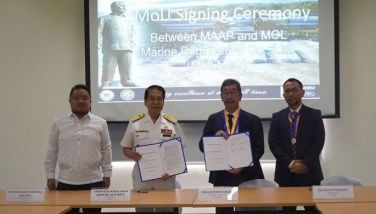Amazing events of the Pacific War
For a dwindling number of Filipinos, the Pacific War is mainly about Bataan and Corregidor, followed by the liberation campaign that saw the destruction of the City of Manila. Some of us know that the Fall of Bataan on April 9, 1942 was the largest capitulation of a US-led force in American history, with Maj. General Eduard King surrendering a Philippine-American force of 75,000 troops to General Masaharu Homma of Japan’s Fourteenth Army.
Even fewer know that earlier, just a day after Valentine’s Day, Feb. 15, 1942, Singapore, the “Gibraltar of the East” and supposedly an impregnable fortress with heavy guns pointing out to the sea, fell to numerically smaller Japanese forces under General Tomoyuki Yamashita.
Let us remember that Pearl Harbor was attacked on Dec. 7, 1941 while Clark Field and Iba Field in Zambales were hit the following day, Dec. 8, wiping out the Far East Air Force of General MacArthur just a few hours after the disaster in Honolulu.
On the same day, Japanese forces landed at several points in northern Malaya and, moving with great speed utilizing trucks and thousands of bicycles, they caught many of the British forces by surprise. The capture of Singapore in just over 70 days after landing in the peninsula proved that the Japanese had the daring, the power and the military skills to stage spectacular offensives against both American and British forces.
Winston Churchill, the wartime British Prime Minister, would write of the fall of Singapore as “the worst disaster and largest capitulation in British history.” Singapore Prime Minister Lee Kuan Yew, in his autobiography, “The Singapore Story,” would say of the Japanese victory, “In just 70 days of surprises and upsets and stupidities, British colonial society was shattered and with it, all the assumptions of the Englishman’s superiority… The British built up the myth of this superiority so convincingly that most Asiatics thought it hopeless to change them. But now one Asiatic race had dared to defy them and smashed that myth.” It is interesting to note that both the Bataan and Singapore capitulations were inflicted by Japanese military forces.
For his stunning conquest in Malaya and Singapore, General Yamashita would be crowned “Tiger of Malaya.” In September 1944, he was appointed commander of all Japanese forces in the Philippines. Unfortunately for him, it was the beginning of the end. Exactly one year after his assumption to his new command, he surrendered to Philippine-American forces in Camp John Hay in Baguio City. His personal sword which he turned over to his captors would find its way to the US military academy at West Point.
Yamashita would be tried for atrocities committed by his troops in different parts of the country but the focus would be on the events that took place during the Battle of Manila. He was charged with “failure to discharge his duties as a commander to control the acts of members of his command, thus permitting them to commit war crimes.” After a 33-day trial, on Dec. 7, 1945, exactly four years after the attack on Pearl Harbor, the presiding judge read out the verdict: Guilty as charged; death by hanging.
The Yamashita decision led to what is known in legal circles as the “Yamashita standard” on command responsibility. It holds that a commander can be held liable for crimes committed by his troops even if he didn’t order them, did not know about them or lacked the means to stop them. It is a standard adopted by several legal conventions and institutions, including the International Criminal Court (ICC).
* * *
?Just two weeks after Pearl Harbor, President Franklin Delano Roosevelt convened his military advisers in his study. He understood that the continued defeats suffered by both the United States and the United Kingdom were demoralizing the American public. He was resolute in finding a way of carrying the war to the Japanese homeland in the form of a top-secret bombing mission. In his best-selling book “Target Tokyo,” author James Scott who gave us “Rampage: MacArthur, Yamashita and the Battle of Manila,” narrates how 16 Army bombers, flown by 80 volunteers specially trained in aircraft carrier takeoffs, carried out an almost impossible, daring raid that sought to avenge the disaster in Hawaii.
The man chosen to oversee the whole project was a former boxer-turned-pilot, James Doolittle. After a quick study of aircraft available for the mission, he chose the B-25 Mitchell bomber, named after aviation pioneer General William “Billy” Mitchell. It was chosen only for one reason – its 67-foot wingspan could clear the superstructure of an aircraft carrier. It also required only five crew members: a pilot, co-pilot, navigator, bombardier and gunner. He wanted only volunteers for the mission. With about 150 officers and men selected, intensive training in carrier take-offs using mock-ups of the B-25 bomber began. By April 2, 16 B-25 bombers with 80 crew members were onboard the aircraft carrier Hornet, sailing out of San Francisco Bay. Except for Doolittle, none of the crew members knew their final destination.
On April 9, Bataan surrendered. In the early hours of April 18, 1942 Colonel Doolittle led the flight of bombers headed for Tokyo. The raiders hit targets mainly in Tokyo, Osaka and Nagoya. While the damage done was minimal, the United States had struck its first blow against Japan, causing tremendous loss of face for the Japanese General Imperial Staff. Of the 80 men who participated in the attack, 61 survived the war, including Doolittle who would live until age 96. He would receive the Medal of Honor for his leadership and courage in the planning and successful execution of the mission. April 18 marks the 81st anniversary of what was once considered as “Mission Impossible.”
- Latest
- Trending





























